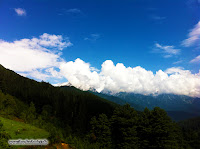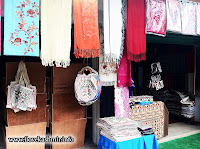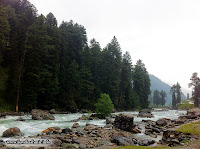Friday, June 15, 2012
Monday, June 11, 2012
Aharbal - The hidden valley of beauty!
Located approximately 65 kilometers to the southeast of Srinagar (Capital of Kashmir) lies a breathtaking abode of one of the best waterfalls in Kashmir, Aharbal.
View Larger Map
Saturday, June 09, 2012
Monday, June 04, 2012
Where beauty meets serenity! Kashmir!
After a long gap of time, today I went out with my family to Srinagar. The weather was very pleasant, the streets were bustling with tourists, gardens blooming with flowers and of course the cool breeze making you feel you are indeed in the ‘Paradise on Earth’. The stroll around the pristine Dal Lake was very pleasant and serene. Everything was so beautiful, the look and smile on everyone’s face was pleasing for the soul. And being with my family was even more gratifying. The day embraced a turn of seasons throughout. The sun played with the clouds all day long while the rain tickled the creatures on ground. Here I share with you some beautiful snapshots of the trip! Hope you like them as much as I cherish the feeling of having been there to capture them!
 |
| A fisherwoman selling a fresh catch on the banks of Dal Lake! |
 |
| Tried hard enough to catch the rainbow in the picture! (On the right) |
Thursday, March 15, 2012
"Horse riding?" in Gulmarg
Holding their hands behind the back, men
in pheran look at tourists getting down from the small bus. A quick look around
brings a smile of happiness... What a peaceful atmosphere! The bright sun of
November is shining above our heads. On the left, the green roofs characterise
the little town. On the opposite side, slightly blurred by winter fog, stand
white mountain tops. All around, eyes can stretch far... far... in the green plain
where a few men ride horses. Pigeons cleave through the sky. At winter
beginnings, Gulmarg is a place to enjoy calm and nature.
Picture: France Lenne
“Horse riding?” a Kashmiri offers, up on his
horse as we walk on the way towards the golf course. A row of horses ridden by
Indian tourists later takes us over. “Horse riding?” the guide asks. Then, we take a shortcut
through the muddy and watery plain. I curse my shoes, which are not at
all appropriate. A green-eyed man on his horse looks down at me, surprised not
to see me on a horse like others.
Indeed, in Gulmarg, it is rare to see a local moving without its horse(s). Horse riding is fully part of Gulmarg and Kashmir life. As a tourist, the landscape can be enjoyed without pain in the legs
and dirty shoes! Above all, it is the opportunity to experience the most
important mean of transport in Kashmir. Horses are very appropriate for hilly
regions such as Kashmir. They are particularly useful in rural areas where road
infrastructures are not well developed. These robust animals serve for pulling carts, carrying burdens and transporting people.. They also provide an income for a poor range of the society. According to Fazili and Kirmani (2011), only landless small farmers own horses which they rent (among all) to tourists in famous
places such as Gulmarg and Pahalgam [1].
In brief, horses
and ponies play a key role in the economy of Jammu and Kashmir. They represent an essential mean of transport for many as well as an important source of income.
So, there is now only one question left to you: "horse riding?!"
[1] Fazili M.R., Kirmani M.A, 2011, Equine: The
Ignored Working Animal of Kashmir: Status, Constraints, Research Areas and Ways
for Improvement, Asian Journal of Animal Science 5 (2), Online Available at: http://scialert.net/fulltext/?doi=ajas.2011.91.101&org=12
Monday, March 05, 2012
Apple - the golden fruit of Kashmir!
Pure Kashmiri Golden apples sold in November in Srinagar streets
Gold and delicious!
Gold and delicious!
Picture: France Lenne
I love apples! Such a beautiful and delicious fruit! My favourite of all! What a great surprise to see all these apples in Srinagar, sold in the streets! As a foreigner, I had no idea of the existence of Kashmiri apples. Quite normal in fact! Kashmir exports only a small percentage of its production abroad (essentially to neighbouring countries Sri Lanka, Bangladesh and Nepal). But apples of Jammu & Kashmir are sold all over India: the region supplies about 70% of apples in India followed by Himachal Pradesh and Uttarakand. Over a million tons! In reason of climate changes, political unrest and lack of cold storage facilities (among all), the production varies up or down over years. But the recent signs of a durable tranquillity since summer 2011 [1] and the development of internet as new sales channel set hopes for growers to have better access to international markets such south Asia and Middle East [2].
The Golden, and above all, the Red Delicious are the most cultivated in Kashmir as they are highly appreciated by Indian consumers. Those species have been first introduced in Himachal Pradesh by the British from 1917 [3]. However, it is an indigenous variety, the Ambri, which remains the most popular in Kashmir. This red striped apple, described as sweet and crisp, is thought to have been cultivated long before western introductions [4].
Since ancient times, Kashmir has been a fertile land for fruit trees. Kashmiri forests are abundant in flora and fauna. The Himalayas form a barrier to both glacial winds from Tibetan plateau and monsoon winds from India. In addition to high altitude, this climatic phenomenon creates a temperate and rainy weather, suitable to the growth of numerous fruit trees. It is known that fruits such as apples were already cultivated 1000 BC under the reign of King Nara as mentioned by P.N. Wanchoo [5].
Designated as tsunt (chunt), the apple is embedded in the Kashmiri culture as a few Kashmiri proverbs attest it. Kashmiris say “An apple gets colour on seeing another apple” (tsunt chu tsunthis vuchith rang ratan) to point a person influenced by the company he/she keeps.
The anecdote of an old woman who came back with a empty basket to collect apples, after having earlier found one under a tree (Bujih labiav kuji tal tsunt, adat gayi phut hit) warns us that when a little is once given, a lot is later expected to be given [6].
[1] Joseph M., 2012, Face of Hope Reflects Calm in Kashmir, New York Times, February 29th 2012, Online Available at: http://www.nytimes.com/2012/03/01/world/asia/01iht-letter01.html?_r=1&ref=kashmir
[2] Wani Izhar, 2004, Kashmir: a byte out of apple market, Online Available at: http://archives.dawn.com/2004/08/26/int12.htm
[3] Ghosh S.P., 1997?, Deciduous fruit production in India, FAO, Online Available at: http://www.fao.org/docrep/004/ab985e/ab985e07.htm
[4] Mota A., 2009, Apples of kashmir, Chinar Shade blog, Online Available at: http://autarmota.blogspot.com/2009/08/apples-of-kashmir.html
[5] Wanchoo P.N., date?, Kashmir - Old Home of Temperate Fruits, Online Available at:
, http://ikashmir.net/koshursamachar/temperatefruits.html
[6] Koul O.N., 2005, A Dictionary o f Kashmiri Proverbs, Second Edition, Delhi: Indian Institute of Language Studies
Labels:
Ambri,
Apple,
Golden Delicious,
Himalayas,
Kashmir export,
Kashmiri apple,
Kashmiri proverb
Saturday, March 03, 2012
Saturday, February 25, 2012
Rabab - A (musical) highlight of Kashmiri culture and identity
The rabab is a musical instrument which is mainly found in Mediterranean and Asian regions of the world including Tunisia, Turkey, Persia (Iran), Afghanistan and Kashmir. The rabab takes different names and shapes according to regions as the making of rababs differ from one rabab maker to another.


Considered as one of the oldest stringed music instruments [1], it is believed that the rabab has given birth to many other instruments, in particular the European violin and the sarod (most prominent instrument of Indian classical music). Since their apparition in the 18th century, these instruments have become so predominant that they threatened the rabab of extinction [2]. However, the (kabuli) rabab remains the national instrument of Afghanistan. It is argued that the rabab has been introduced in Kashmir through the migration of a tribe (the rohillas) originating from Afghanistan [3].
The main characteristics of Afghani and Kashmiri rababs are a bulging body, an indented waist, four to six strings and side pegs called tarab khunti [4]. They are usually made of almond or mulberry wood, but commonly made of walnut wood in Kashmir. Both are plucked. This differs from other rababs which are played with a bow.
In Kashmir, the rabab is fully part of folk music, in particular in Chakri music (music played during wedding ceremonies). More specifically, the rabab is played by sufis to accompagny poetry. It is considered as an instrument of spiritual elevation [5]. As sufism has particularly deep roots in Kashmir, the rabab is the essence of the Kashmiri Sufiana Kalam (Sufi music).
Labels:
Afghani rabab,
Chakri,
kashmiri music,
Kashmiri rabab,
rabab,
sufi music
Thursday, February 23, 2012
Rabab - The essence of Sufi Music in Kashmir!
This is an Afghan song "Da Zmonzh Zeba Watan" (Our Beautiful Country) by Ustad Awal Mir played in this video by Semira Azadzoi (Age 16) assisted with Tabla by Masoud Omari in a fund raising concert at Bently University to help the poor in Afghanistan.
She also mentions Kashmir as a place where Rabab is an important musical instrument.
Enjoy and be mesmarised.
She also mentions Kashmir as a place where Rabab is an important musical instrument.
Enjoy and be mesmarised.
Labels:
kashmir video,
kashmiri music,
rabab,
sufi music
Friday, February 17, 2012
Tuesday, February 14, 2012
Sunday, February 12, 2012
Friday, February 10, 2012
Thursday, February 09, 2012
Subscribe to:
Posts (Atom)















































